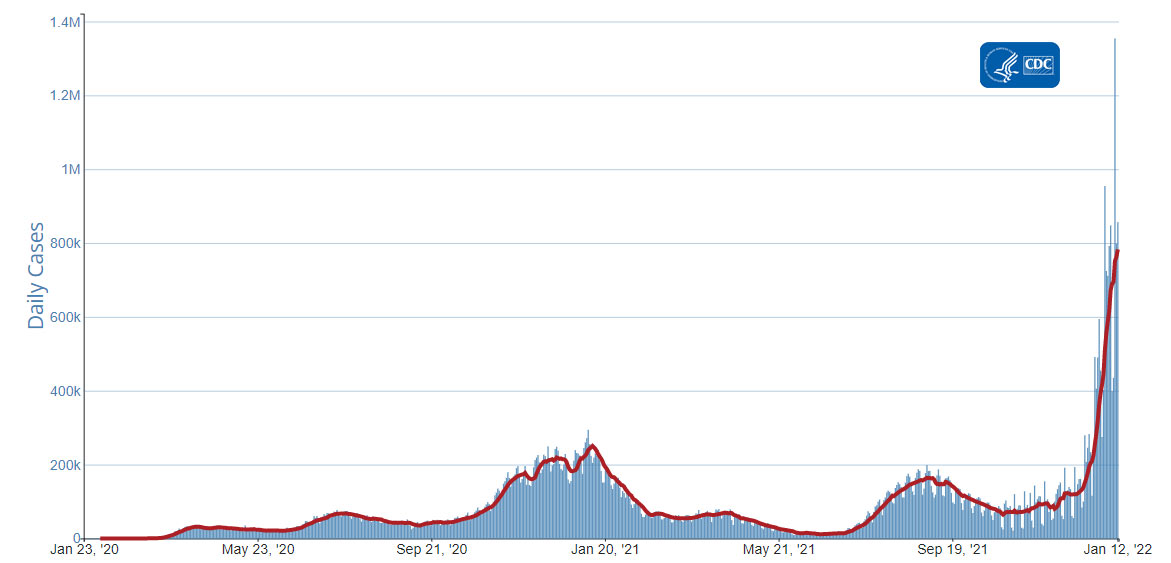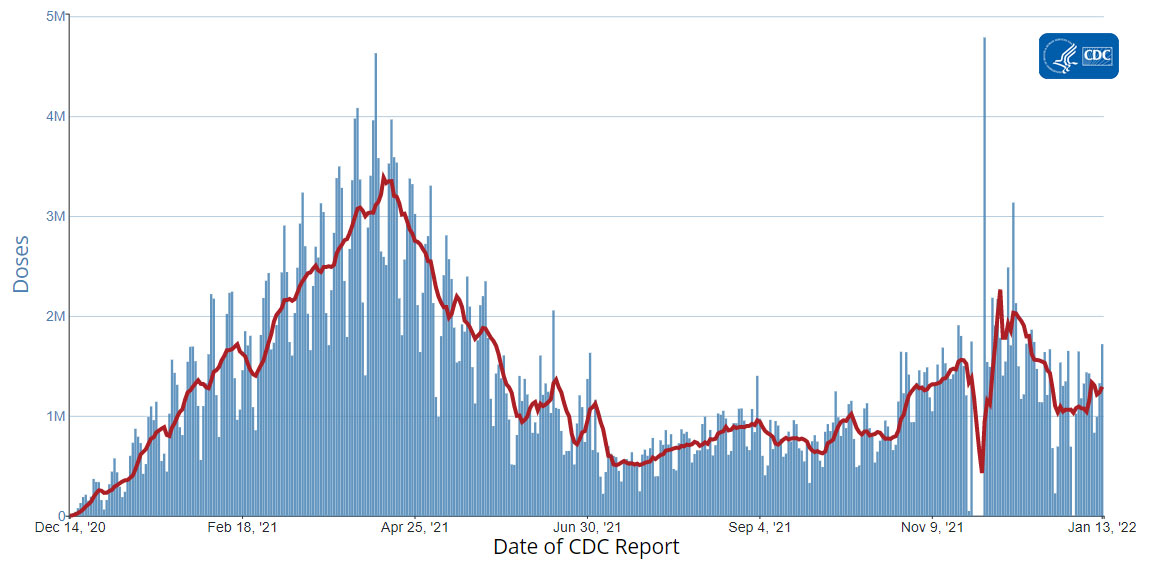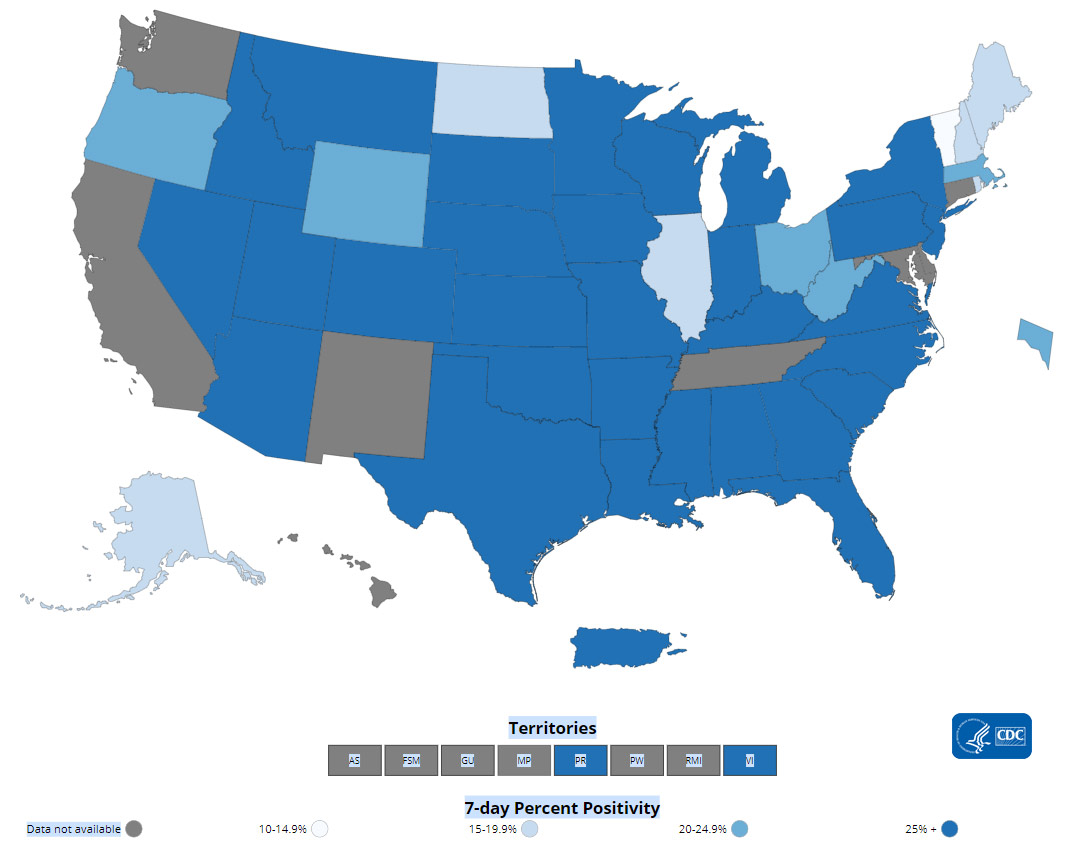Recommendations for Fully Vaccinated People
COVID-19 Homepage
Keep Kids Safe
Interpretive Summary for January 14, 2022
Keep Kids Safe
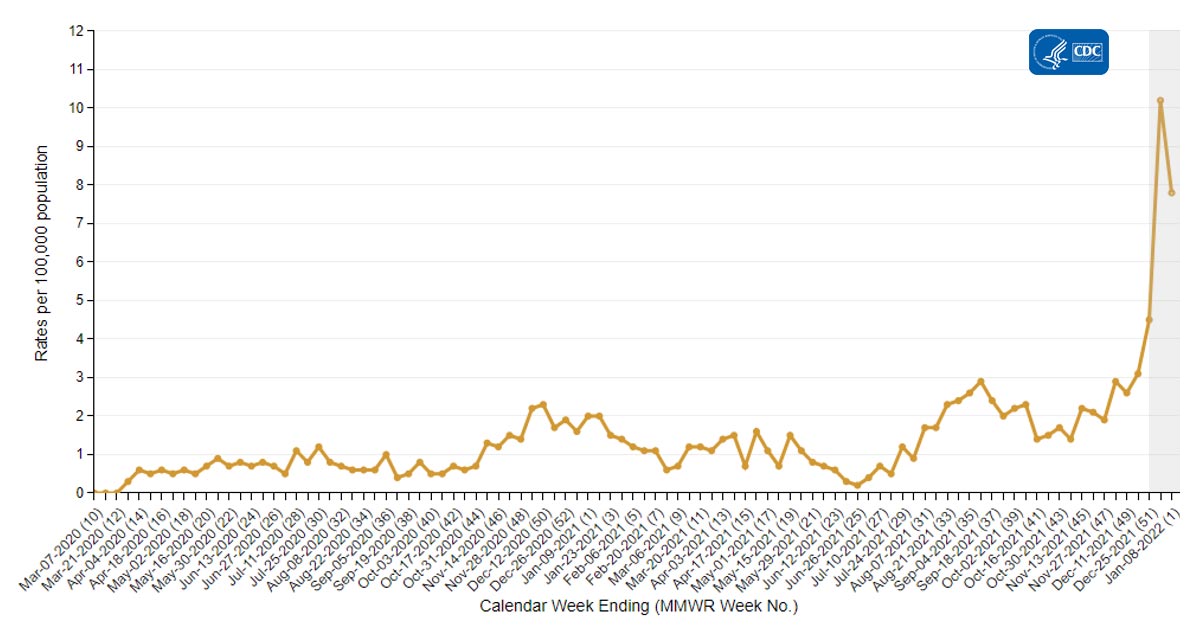
The Coronavirus Disease 2019 (COVID-19)-Associated Hospitalization Surveillance Network (COVID-NET) hospitalization data are preliminary and subject to change as more data become available. In particular, case counts and rates for recent hospital admissions are subject to lag, and the weeks most likely affected are indicated by the gray box. Lag for COVID-NET case identification and reporting might increase around holidays or during periods of increased hospital utilization. As data are received each week, prior case counts and rates are updated accordingly.
COVID-19 cases, hospitalizations, and deaths continued to rise in the first week of January. Community transmission remains high throughout the United States. These trends are driven by the Omicron variant, which now accounts for approximately 98% of cases in the country.
COVID-19 tends to be milder in children compared with adults, but CDC’s COVID-NET shows that pediatric hospitalizations with or for COVID-19 are now at their highest rate since the start of the pandemic. Most of these hospitalizations are because of COVID-19, although some are children who were admitted for other causes but tested positive for COVID-19 when they were admitted or during their hospital stay. The highest hospitalization rates among all children are in those ages newborn to 4 years, who are not yet eligible for vaccination. Omicron does not appear to cause more severe disease in children than other variants of the virus, and overall rates of pediatric hospitalizations are still lower than in any adult age group. But because of the rapid spread of COVID-19 cases across the country, we anticipate that these numbers will continue to increase in the coming weeks.
We know how to keep kids safe—even those who are too young to be vaccinated. Parents, guardians, and people who care for and are around young children can protect them by wearing well-fitting masks and getting vaccinated and boosted. CDC recommends everyone ages 5 years and older get a COVID-19 vaccine to help protect against COVID-19. Fully vaccinated people ages 12 years and older should get a COVID-19 booster shot. To find a vaccination site near you, visit vaccines.gov, text your ZIP code to 438829 (GETVAX), or call 1-800-232-0233. If you have questions about COVID-19 vaccines in children, talk with your child’s pediatrician or healthcare provider.
- CDC’s COVID Data Tracker’s Disease Severity Among Hospitalized Patients tab now allows users to view monthly trends in disease severity by age, sex, or race/ethnicity from 3 different data sources.
- CDC’s COVID Data Tracker’s Vaccinations in the United States tab now shows the count and percent of the U.S. population that are eligible for a booster dose but have not yet received one.
- Effectiveness of BNT162b2 (Pfizer-BioNTech) mRNA Vaccination Against Multisystem Inflammatory Syndrome in Children Among Persons Aged 12–18 Years — United States, July–December 2021
- Risk for Newly Diagnosed Diabetes >30 Days After SARS-CoV-2 Infection Among Persons Aged <18 years — United States, March 1, 2020–June 28, 2021
Reported Cases
As of January 12, 2022, the current 7-day moving average of daily new cases (782,766) increased 33.2% compared with the previous 7-day moving average (587,723). A total of 63,397,935 COVID-19 cases have been reported in the United States as of January 12, 2022.
Currently two variants, Omicron and Delta, are classified as Variants of Concern (VOC) in the United States. CDC Nowcast projections* for the week ending January 8, 2022, predict the national proportion of Omicron to be 98.3% (95% PI 96.9-99.1%) and Delta to be 1.7% (95% PI 0.9-3.0%). Omicron is predicted to be greater than 90% in all HHS regions.
63,397,935
Total Cases Reported
63,397,935
Total Cases Reported
782,766
Current 7-Day Average**
782,766
Current 7-Day Average**
587,723
Prior 7-Day Average
587,723
Prior 7-Day Average
+33.2%
Change in 7-Day Average since Prior Week
+33.2%
Change in 7-Day Average since Prior Week
*The median time from specimen collection to sequence data reporting is about 3 weeks. As a result, weighted estimates for the most recent few weeks may be unstable or unavailable. CDC’s Nowcast is a data projection tool that helps fill this gap by generating timely estimates of variant proportions for variants that are circulating in the United States. View Nowcast estimates on CDC’s COVID Data Tracker website on the Variant Proportions page.
**Historical cases are excluded from daily new cases and 7-day average calculations until they are incorporated into the dataset for the applicable date. Of 352,811 historical cases reported retroactively, none were reported in the current week and 134 were reported in the prior week.
Vaccinations
The U.S. COVID-19 Vaccination Program began December 14, 2020. As of January 13, 2022, 524.2 million vaccine doses have been administered in the United States. Overall, about 248.0 million people, or 74.7% of the total U.S. population, have received at least one dose of vaccine. About 208.6 million people, or 62.8% of the total U.S. population, have been fully vaccinated.* About 78.1 million additional/booster doses in fully vaccinated people have been reported. As of January 13, 2022, the 7-day average number of administered vaccine doses reported (by date of CDC report) to CDC per day was 1,291,013, a 20.4% increase from the previous week.
CDC’s COVID Data Tracker Vaccination Demographic Trends tab shows vaccination trends by age group. As of January 13, 2022, 95.0% of people ages 65 years or older have received at least one dose of vaccine and 87.9% are fully vaccinated. For people ages 18 years or older, 86.7% have received at least one dose of vaccine and 73.4% are fully vaccinated. For people ages 12 years or older, 84.7% have received at least one dose of vaccine and 71.7% are fully vaccinated. For people ages 5 years or older, 79.4% have received at least one dose of vaccine and 66.8% are fully vaccinated.
524,199,956
Vaccines Administered
524,199,956
Vaccines Administered
247,987,225
People who received at least one dose
247,987,225
People who received at least one dose
208,564,894
People who are fully vaccinated*
208,564,894
People who are fully vaccinated*
74.7%
Percentage of the U.S. population that has received at least one dose
74.7%
Percentage of the U.S. population that has received at least one dose
62.8%
Percentage of the U.S. population that has been fully vaccinated*
62.8%
Percentage of the U.S. population that has been fully vaccinated*
+0.8
Percentage point increase from last week
+0.8
Percentage point increase from last week
+0.5
Percentage point increase from last week
+0.5
Percentage point increase from last week
*Represents the number of people who have received the second dose in a two-dose COVID-19 vaccine series (such as the Pfizer or Moderna vaccines) or one dose of the single-shot Johnson & Johnson’s Janssen vaccine.
Hospitalizations
New Hospital Admissions
The current 7-day daily average for January 5, 2022–January 11, 2022, was 20,637. This is a 24.5% increase from the prior 7-day average (16,571) from December 29, 2021–January 4, 2022.
3,919,141
Total New Admissions
3,919,141
Total New Admissions
20,637
Current 7-Day Average
20,637
Current 7-Day Average
16,571
Prior 7-Day Average
16,571
Prior 7-Day Average
+24.5%
Change in 7-Day Average
+24.5%
Change in 7-Day Average
The start of consistent reporting of hospital admissions data was August 1, 2020.
Daily Trends in Number of New COVID-19 Hospital Admissions in the United States

New admissions are pulled from a 10 am EST snapshot of the HHS Unified Hospital Timeseries Dataset. Due to potential reporting delays, data from the most recent 7 days, as noted in the figure above with the grey bar, should be interpreted with caution. Small shifts in historic data may also occur due to changes in the Centers for Medicare and Medicaid Services (CMS) Provider of Services file, which is used to identify the cohort of included hospitals.
COVID-NET: Hospitalization Rates in Children Ages 4 Years and Younger
CDC’s Coronavirus Disease 2019-Associated Hospitalization Surveillance Network (COVID-NET) shows that hospitalization rates continue to rise in young children. For the week ending December 25, the weekly rate of COVID-19-associated hospitalizations for children ages 4 years and younger is 4.5 per 100,000. The rate of hospitalization in this age group is higher than rates seen for both older children ages 5–11 years (1.1 per 100,000) and adolescents ages 12–17 years (2.6 per 100,000). Unlike older children and adolescents, children ages 4 years and younger are not yet eligible for any of the available COVID-19 vaccines.
Hospitalization Rates in Children Ages 4 Years and Younger
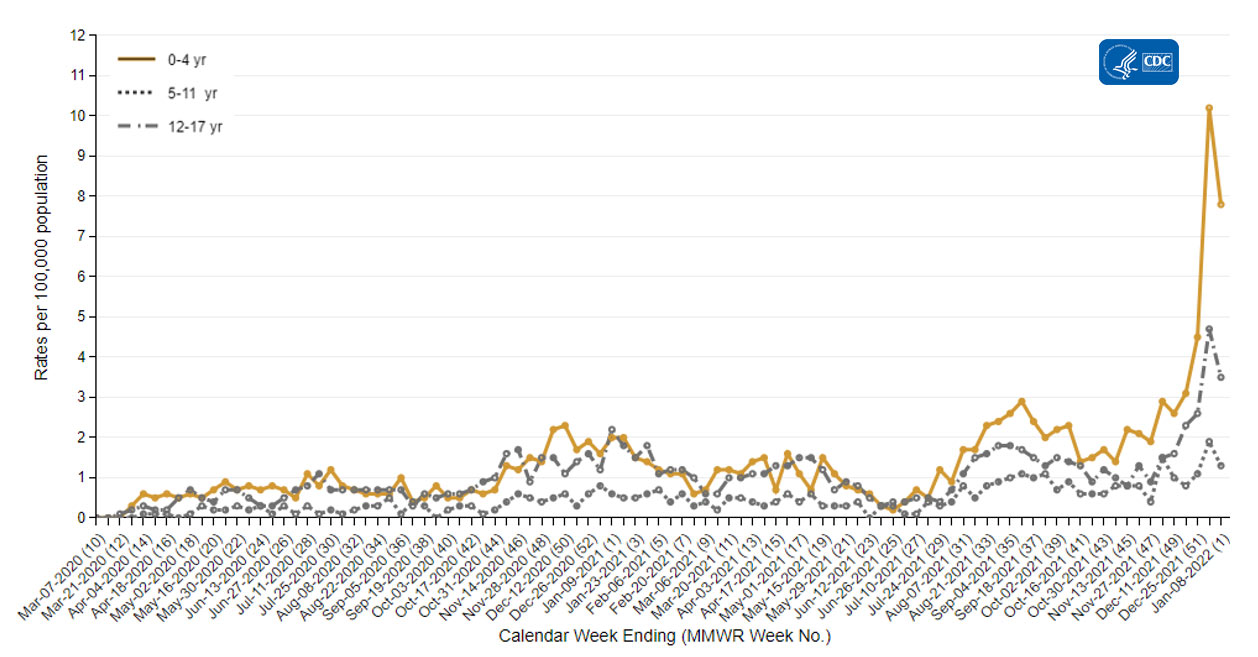
The Coronavirus Disease 2019 (COVID-19)-Associated Hospitalization Surveillance Network (COVID-NET) is an additional source for hospitalization data collected through a network of more than 250 acute-care hospitals in 14 states (representing ~10% of the U.S. population). Detailed data on patient demographics, including race/ethnicity, underlying medical conditions, medical interventions, and clinical outcomes, are standardized case reporting form.
Deaths
The current 7-day moving average of new deaths (1,729) has increased 36.8% compared with the previous 7-day moving average (1,264). As of January 12, 2022, a total of 842,873 COVID-19 deaths have been reported in the United States.
842,873
Total Deaths Reported
842,873
Total Deaths Reported
1,729
Current 7-Day Average*
1,729
Current 7-Day Average*
1,264
Prior 7-Day Average
1,264
Prior 7-Day Average
+36.8%
Change in 7-Day Average Since Prior Week
+36.8%
Change in 7-Day Average Since Prior Week
*Historical deaths are excluded from the daily new deaths and 7-day average calculations until they are incorporated into the dataset by their applicable date. Of 19,850 historical deaths reported retroactively, 418 were reported in the current week; and 337 were reported in the prior week.
Daily Trends in Number of COVID-19 Deaths in the United States Reported to CDC

7-Day moving average
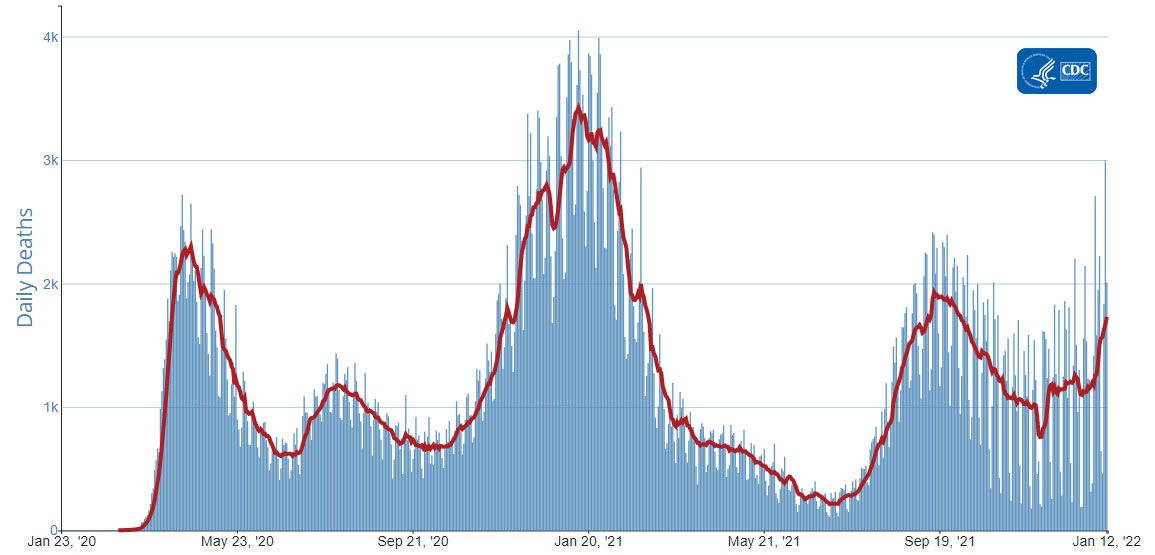 More Death Data
More Death DataTesting
The percentage of COVID-19 NAATs (nucleic acid amplification tests)* that are positive (percent positivity) is increasing in comparison to the previous week. The 7-day average of percent positivity from NAATs is now 28.6%. The 7-day average number of tests reported for December 31, 2021 – January 6, 2022, was 2,147,177, up 25.6% from 1,709,893 for the prior 7 days.
742,767,508
Total Tests Reported
742,767,508
Total Tests Reported
2,147,177
7-Day Average Tests Reported
2,147,177
7-Day Average Tests Reported
28.6%
7-Day Average % Positivity
28.6%
7-Day Average % Positivity
27.8%
Previous 7-Day Average % Positivity
27.8%
Previous 7-Day Average % Positivity
+0.75
Percentage point change in 7-Day Average % Positivity since Prior Week
+0.75
Percentage point change in 7-Day Average % Positivity since Prior Week
*Test for SARS-CoV-2, the virus that causes COVID-19

